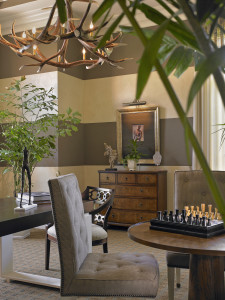Lumens. Lamps. Kelvins. CFLs. LED. How did the world of lighting come to be so complicated when all we used to do is flip a switch?
The answer is, like most things in design, lighting is more sophisticated and offers more options and choices than ever. It is computerized, integrated and vastly more interesting for designers and consumers alike.
A good lighting plan will set the stage for the design of a space. It begins with a simple checklist of the lighting that is available and the lighting that is needed for the uses of the space.

Steven Allen Photography, courtesy of Beasley & Henley Interior Design
Natural sunshine is usually the most desired lighting. Homeowners love to capture the warm feeling that sunlight provides, making it a natural resource for builders. To capitalize on this and maximize its effect, architects can conform rooms to an orientation that allows maximum sun. Interior designers also can ensure that windows are unobstructed by heavy draperies or large pieces of furniture that would intrude into the sunlit world.
Ambient or general room lighting is the next layer for room illumination. It will compensate when natural light is insufficient or supplement the natural light where and when it might be needed. There are many attractive overhead fixtures that provide ample room light. For example, a chandelier or pendant or a series of halogen-lighted recessed cans will provide different options. If an overhead isn’t possible, lamps or wall fixtures with floodlighting for ambient lighting provide good general lighting.

Steven Allen Photography, courtesy of Beasley & Henley Interior Design
Task or specialty lighting is used to illuminate specific items or specialty areas and leads to some of the most creative lighting designs. For example, a pin light from the ceiling can spot a piece of artwork. Wall washers can highlight a gallery. Under-cabinet halogen lights in the kitchen or on a large bookshelf can counteract cabinet shadows and also provide task lighting at the same time. Cove lighting in a ceiling design provides soft mood lighting.
Style and Scale Matter
While the initial lighting plan considers the type of the lighting needed, the next step of that plan should consider the finishing touches. Too often lighting fixtures are treated as an afterthought when in reality decorative finishes are as integral to the overall design of a room as the sofa style, paint color or cabinet designs.

Steven Allen Photography, courtesy of Beasley & Henley Interior Design
When walking through model homes, we too often see many of the same dated fixtures that have been in builder lineups for decades. Not only are these passé, they often are under-scale for today’s home and large lighting styles. Builders who expand vendor sources to find more current lighting options soon realize that there are many inexpensive and attractive options available.
In addition to finding better vendor sources, builders should be aware of new trends in lighting design such as bold, oversized lights, drum chandeliers, eclectic styling such as incorporating antlers and recycled materials, industrial-influenced styles, large oblong or oval pendants, and pieces that are jeweled and brightly colored. These are just a few of the today’s new design options.
Better lighting does not have to break the bank, and it lets buyers know a builder is paying attention to the trends and details of today’s homes.

